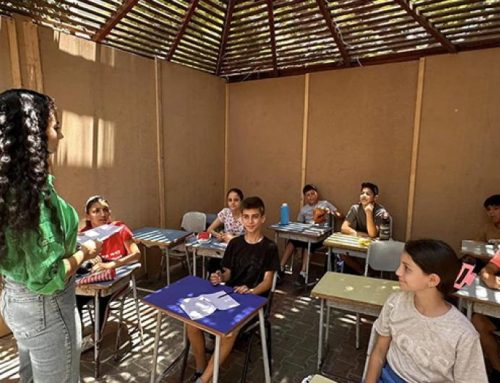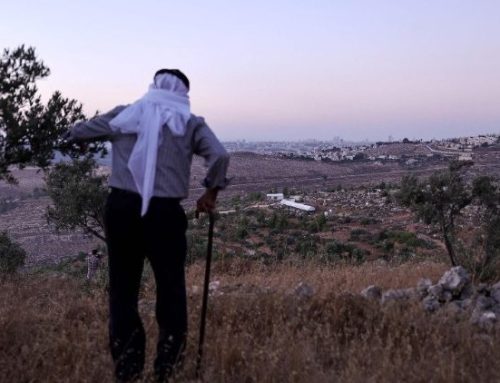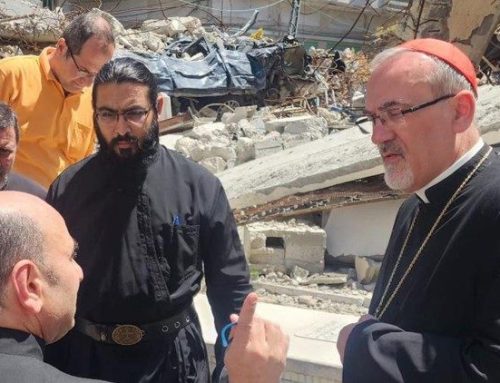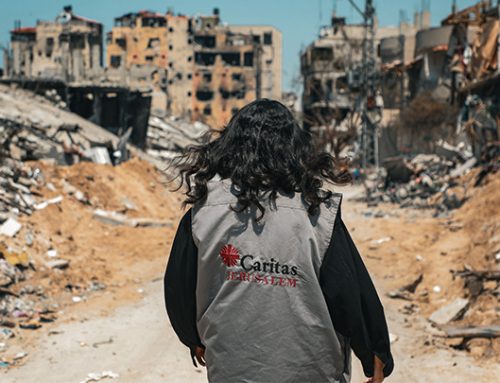Laughter opened and closed the day as the city of Bethlehem welcomed 1000 wide-eyed children from thirteen Palestinian villages and Jerusalem to the ancient city of Jesus’ birth.
Laughter opened and closed the day as the city of Bethlehem welcomed 1000 wide-eyed children from thirteen Palestinian villages and Jerusalem to the ancient city of Jesus birth. From nearby Beit Jala and from more distant Nablus, from small villages like Aboud and larger towns like Ramallah, they came to celebrate the Christmas season in the city at the heart of the Christmas story many making this pilgrimage for the very first time.
These Arab Christian children came as participants in HCEF’s second Journey to Bethlehem, a now annual project administered by the foundation’s Jesus Loves the Children program. Whereas last year’s Journey was a much-needed spark following a dismal turnout of visitors, in many ways this second Journey was the emphatic exclamation point on the most successful tourist season Bethlehem has seen in six years. Even as foreign pilgrims are returning to the city, the great paradox of this second Journey is that these children faced a more uncertain road into Bethlehem than their predecessors from just one year ago. The unchecked growth of the Separation Wall and a tightened grip at the main checkpoints into the city have made passage for Palestinians – even children – almost impossible. Now more than ever, having seen what they have seen, these children must become ambassadors of hope in their hometowns.
Judged by the spirit on display during their march through the streets of Bethlehem, participants in this year’s Journey to Bethlehem are more than up to the task. Local Holy Land Christian Support Network (HCSN) members helped instill holiday cheer in the children with songs and cheers as all gathered before the march. To match their cheerful faces, the children all wore bright-colored hats, each color representing a particular village. Some carried banners emblazoned with messages of peace and freedom, proclaiming to the world – in both Arabic and English – their desires for a better tomorrow. “May the Lord give you peace at all times”( 2 Thessalonians 3:16), read one, while another made plain, “You were called to freedom (Galatians 5:13).” Perhaps surpassing the sight of the procession was the joyful noise they spread through the streets. In advance of the children, a local scout troop marched in step to the beat of their drums and horns. The children themselves sang carols on their way to the Church of the Nativity, drawing not a few smiles from the townspeople they passed.
HCEF’s president, Sir Rateb Rabie, KCHS, walked at the head of the procession not only to enjoy the children’s display of the Christmas spirit, but also to demonstrate the importance of the Journey to Bethlehem to the foundation and the Arab Christians it serves. We’ve come, first, to celebrate Christmas right here where our Lord was born,” he said. “But the real motivation behind HCEF’s Journey to Bethlehem is serving the children, especially those who have never made this pilgrimage before. Unity is our best hope for peace, and that unity starts with these children.” Walking with Sir Rateb Rabie as exemplars of the cooperation and solidarity the march inspired were Dr. Victor Batarseh and Hani Hayek, the Christian mayors of Bethlehem and neighboring Beit Sahour respectively.
More than an occasion of civic or national pride, the Journey to Bethlehem was also an expression of the ecumenism at the heart of HCEF’s mission. Coming from more than fifty different parishes and with representatives of no less than ten Christian denominations – Catholic, Orthodox, and Protestant – the children were a living, breathing lesson in Christian unity. Joining them, though, were some of the region’s most respected religious leaders. His Excellency Atallah Hanna, a Bishop in the Greek Orthodox Church, was with the procession from its very beginning and was warmly received by the children.
His Beatitude Michel Sabbah, the sitting Latin Patriarch and leader of the Holy Land’s Roman Catholic faithful, also participated in the procession – his second march through the streets of Bethlehem in as many months. When last he came to the city, for Midnight Mass in December, the Patriarch delivered a message about the importance of justice and peace between neighboring nations. On this journey, too, His Beatitude turned his thoughts to the challenges of living under occupation. Addressing the children with a message of hope, he encouraged them to consider that “even you who are suffering – at checkpoints, behind the Wall – can still come here to Bethlehem and pray.” His Beatitude was joined by Bishop Fouad Twal, also of the Latin Patriarchate, who spoke of the great example the children set in waking so early and traveling so many hours to visit the Church of the Nativity. “We want to be like you,” he said, “to grow in faith like you.”
The testimony of the Patriarch and Bishop Twal spoke volumes about how important the “Living Stones,” practicing Christians, are to the prospects for peace. Certainly the sight of 1000 Arab Christian children flooding into Manger Square – olive branches in hand – was a sight filled with hope. Not only was that hope reflected in the locals who watched the children take their last steps towards the Church of the Nativity, but it also drew the attention of conscientious Christians from abroad, particularly Europe and the West. His Grace Archbishop Patrick Kelly, Vice-President of the Catholic Bishops’ Conference of England and Wales and an HCEF Advisory Board member, marched with the children for the second consecutive year. He spoke much of peace during the ecumenical prayer service held inside the church. “Jesus asks us to follow him to Jerusalem, where all roads lead,” Archbishop Kelly said. “If we listen closely to that word, we realize that ‘Jerusalem,’ ‘salaam,’ ‘shalom,’ all mean peace.” The Archbishop did more than speak, though, as he taught the children how to sign “follow,” “Jesus,” and “peace” using their hands. Archbishop Kelly was not the only Western Christian in attendance. Others, including Monsignor Peter Fleetwood from the Council of European Bishops Conference, came to witness the young peacemakers at work.
For all the children meant to those around them, and for all the memorable impressions they made, surely the day’s highlight for many of them was the chance to pray in the Church of the Nativity. They carried the world’s hope for peace right into the heart of all Christian hope: the site of Jesus’ birth. After the prayer service, the children were led, village by village, down to the grotto beneath the church’s altar. There many said silent prayers to themselves just inches away from the manger noted in Luke’s Gospel (2:7). For Khader, a nine year-old from Aboud, this was his first pilgrimage to the Church of the Nativity. “It’s bigger than other churches in the West Bank,” he said. “It’s one of the oldest, too. I’m very happy I got to see it today.”
Of course, it wouldn’t be a Christmas celebration without gifts. After the prayer service, the children made their way to the Terra Sancta School, adjacent to the Church of the Nativity, where the bishops handed out gifts of Christmas chocolate. Caritas Jerusalem also sponsored lunch for all 1000 children. After lunch, the children gathered in the school’s theater for a show. The Bethlehem Bible Society performed a puppet show complete with sound effects, a fog machine, and magic tricks. The story was about a young boy, Marwan, who thinks only of presents at Christmas time. Until one day he meets Santa Claus, who teaches Marwan that Christmas is the celebration of Jesus’ birth. Following the puppet show, Sabreen, a Palestinian music institute, performed a short percussion set – using pots, pans, plastic garbage bins, and empty water bottles as instruments. Suffice it to say both shows were a hit amongst the students, who laughed at the puppets’ antics and clapped in rhythm to Sabreen’s beats before boarding buses bound for villages all across Palestine.
The day’s success did not belong solely to any one organization. Meeting the needs of so many children was done thanks in large measure to a number of organizations and individuals contributing to the cause. In addition to Sabreen, the Bethlehem Bible Society, and Caritas Jerusalem, local causes such as the Pontifical Mission to Palestine and the Franciscan Custody of the Holy Land lent their support. The generosity of sponsors in the United States was every bit as critical. The Journey to Bethlehem would never have been possible without the help of St. Jude Catholic Church (Rockville, MD), Market Square Presbyterian Church (Harrisburg, PA), St. Andrew Catholic Church (Milford, OH), Lewinsville Presbyterian Church (Mclean VA), the MMUMC Women, and St. Rose of Lima School. Solidarity between groups in the Holy Land and the United States has always been at the heart of HCEF’s mission and it was much in evidence during the Journey to Bethlehem.
HCEF’s Bethlehem office staff also merit special mention for the tremendous job they did in planning and executing this remarkable event. George Ghattas, HCEF’s Country Representative, provided invaluable leadership.
It is clear that HCEF’s Second Annual Journey to Bethlehem meant a great deal to a great many. More than anything, though, it was an expression of HCEF’s core mission – a wonderful opportunity to replace despair with hope, fear with security, and humiliation with human dignity.





